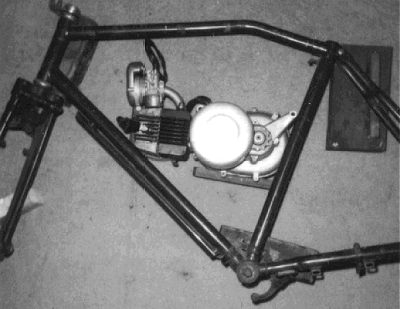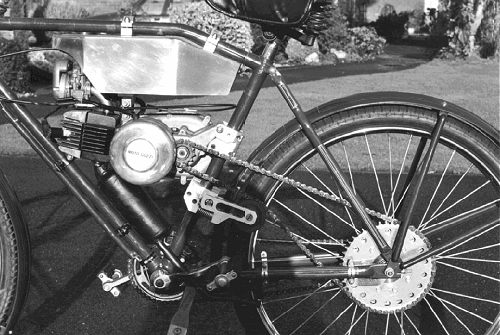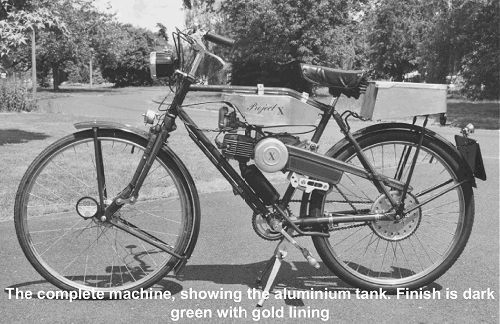 Go
to the Archive index
Go
to the Archive indexIn 1986, at bring and buy evening at my local VMCC section, I was attracted to a small two-stroke engine a gentleman had brought along for auction. When it came up for sale there were a few derisory bids of a pound or so, so I offered a modest bid of £15 and it was knocked down to me. Talking to him following the sale, he told me that it was an engine that had originally been considered for the NVT Easy Rider, but rejected in favour of a Moto Morini engine, which has a pedal shaft bearing cast into the rear of the gear case.
It turned out that the engine is a 49cc single speed Moto Guzzi engine. There is no engine number, just "Moto Guzzi CH" stamped on the crankcase. After subsequently talking to Alistair Currie, the then Moto Guzzi Marque Enthusiast, he kindly sent me details of the Moto Guzzi Chiu moped, which first made its appearance at the Milan motorcycle show in November 1973. This shows a similar engine fitted into a neat little moped with 16in wheels, manufactured until 1976 but, to the best of my knowledge, not sold in this country. The engine appeared to be shop soiled, but as far as I could tell, was unused.
The engine cluttered up the shed for several years with me looking at it from time to time thinking that it was a pity that I couldn't make use of it, then a friend told me that he had a bike frame for cyclemotors which he was willing to do a swap with. We did a deal for an old acetylene trench lamp and £20. The frame turned out to be the robust BSA one with the Webb front forks that BSA sold in the 1950s complete less the wheels for the princely sum of 7gns. Mainly intended for their Winged Wheel, but their advert of the time states that it is suitable for other makes of cyclemotor. Just the ticket for fitting the Guzzi engine into. There were no wheels, the mudguards were there, the rear one was cut in half with marks on the frame showing that a friction drive engine had been fitted at some earlier date, no paper work but a rear number-plate bearing a Staffordshire number of 1954.
I had been on many a cyclemotor run in company with much missed late friend and cyclemotor guru, Stan Greenway. Stan had various cyclemotors, but I particularly admired his Rex, now owned by another cyclemotoring friend, Robert Pearce. I had always thought it to be a very sound machine and a good design as a basis for my proposed cyclemotor. I laid the frame flat on the garage floor, positioned the engine in it and took measurements so that with the aid of my lathe and vertical slide I could carve mounting clamps out of blocks of aluminium. When I had the engine clamped firmly in the frame I made a cardboard petrol tank to suit the gap between the engine and the cross-bar, then fabricated one out of aluminium using the cardboard as a pattern. I welded the tank together with Lumiweld, which is a marvelous product and brings aluminium welding within the range of the do-it-yourselfer.

Frame and engine ready for measuring
The engine had mounting lugs on the top and to the rear of the gear-case, in the rear it was a straight forward case of clamping to the saddle tube, but the top mounting was more complicated. I solved the problem by welding two hollow columns through the tank, so that the cross bar clamp was pulled tight against the top of the columns and the bottom fixing pulled up against the underside by means of 6mm high tensile studding passing all the way through. As an after thought, I added a steel bracket attached to the bottom cylinder head studs and clamped round the down tube, the idea of this was to counteract any tendency for the pull of the drive chain to swivel the engine unit round on the saddle tube.
I was not sure what size sprocket I should need, so took a guesstimate based upon the Rex, but altering the ratio slightly to allow for the more recent design of engine. I ordered a sprocket blank from Sprockets Unlimited, shaved it down to fit between the chain side plates, and bored it to fit a boss that I had made to fit closely onto the hub, so that it would take the main pull of the chain. I wanted the drive to be taken by the spokes as it is on the Rex. I machined a rather over-engineered sprung jockey wheel for the drive chain, lengthened and modified an old chain guard for the drive side. Made a silencer out of a small gas bottle (that Halfords sell for their welding sets) incorporating the device that creates back pressure from the original pan type silencer.

The engine and tank mountings and chain tensioner
All this took some time as I was slowed down by problems with a "dicky ticker" and was subsequently in hospital for a heart by-pass. In the meantime the unfinished project stood in the garage/workshop creating a certain amount of interest amongst my motor cycling friends, so I wrote "Project X" on a card and fastened it on the wall above the machine.
I wanted the finished machine to have good brakes, and hub brakes are difficult to get hold of in this country. My Dutch friend who lives in a small village, but as with all small villages in Holland, has a good cycle shop, sent me a second hand Sturmey-Archer front drum brake and a coaster hub for the rear wheel. The frame has provision for a stirrup brake on the rear wheel, which I have fitted. With the coaster hub is very useful to be able to slow down using the back pedal brake, when giving hand signals.
I finished the project and wanted to get it registered, and contacted David Casper. I had previously had the frame and engine dated at 1953 for the frame and early 1970s for the engine, but David thought that because of the discrepancy between the date of manufacture of the frame and engine that I would be forced to have to have a "Q" plate, but this I didn 't want at all. In desperation I telephoned the Northampton Licensing office telling them the full story. I was told by a very helpful gentleman that it was the age of the frame that decides the registration date and not that of the engine, and if I filled in the form that he would send me, returning it together with photos of the machine, clearly showing the frame and engine numbers (CH being acceptable as the engine number), an MoT, insurance certificate and of course the fee, then if all was well they would issue an age related number. He added the proviso that I might be required to take it to the office for inspection. I did as I was told, including sending a rubbing of the frame number for good measure, the frame dating certificate and photocopy of the BSA frame advert supplied to me by Roger Caunt, the BSA Marque Enthusiast. Quite shortly afterwards I was overjoyed to receive an age-related number and the necessary documents.

How does it perform on the road? Well I had over done the gearing a little, with a rear sprocket of 48 teeth it would go quite quickly but the power fell off on hills. I got another blank made with 51 teeth and that seems just fine. It will pull up quite steep hills without LPA ,and by virtue of its centrifugal clutch will pull away from stationary without pedaling. Also, and this is rather strange, it doesn't seem to be any slower; I suppose that is because the lower gearing lets the engine revs develop to a better point on the torque curve. I am still running in, but it has quite a turn of speed and looks as if it will cruise at 25 mph. Its first real outing was on the VMCC Stan Greenway run. I had originally fitted a wireless type cycle computer; I suppose they work very well on an ordinary push bike but it did not like to work anywhere in the vicinity of electricity generation and came up with a meaningless display more like a fruit machine. I have now fitted a basic wire connected type from Halfords and that works well.
I find the sprung front forks very comfortable, also the cushioning effect of the carrier rear tyre and I am looking forward to entering it in the 100-mile run, which after having done it twice on a Scamp and once on a Cyclemaster should be a revelation in luxurious travel.
First published, December 2004